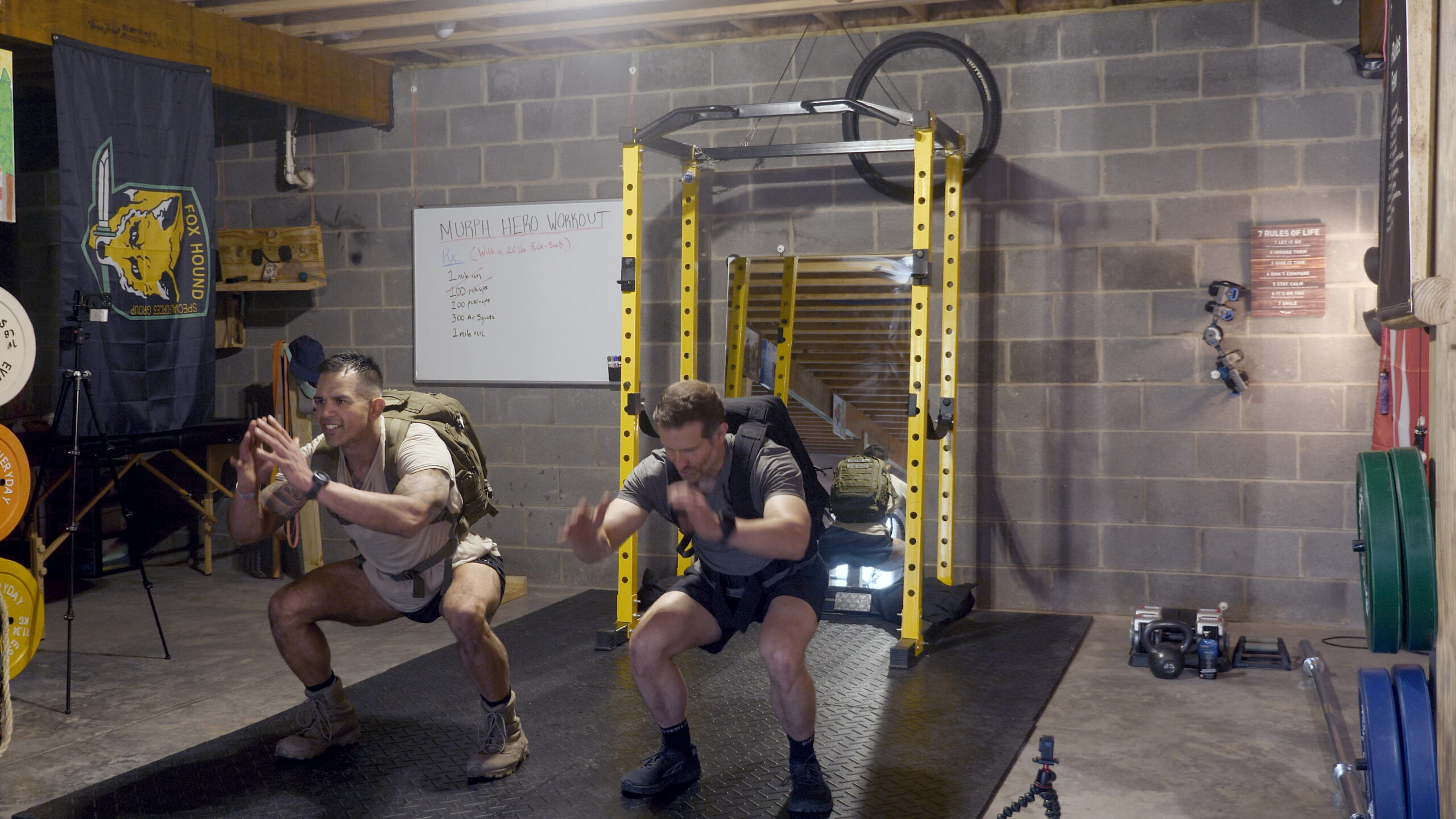
Memorial Day Murph Challenge: Honor, Suffer, and Grow Stronger
The Murph Challenge is more than just a grueling hero workout—it’s a powerful way to honor Navy SEAL Lt. Michael Murphy and push yourself with purpose. Wearing a weighted rucksack and grinding through miles and reps, we tested our limits, remembered the fallen, and came out stronger.
Table of Contents
- What Is the Murph Challenge?
- Why We Did It
- The Breakdown: Stage by Stage
- Why It Matters (and Why You Should Try It)
- Ready to Take It On?
Memorial Day Murph: Suffer With Purpose, Sweat With Honor
Have you ever stare down a WOD and think, “Yeah, this is gonna hurt… but it’s gonna mean something”?
That’s the Murph Challenge.
Every year on Memorial Day, thousands of people strap on a weighted vest or ruck and tackle a grueling workout, not for likes or ego, but for something bigger. We completed Murph with 20-pound rucks, sore muscles, and full hearts. Here’s why.
What Is the Murph Challenge?
Let’s paint the picture. You’re rocking a 20-pound ruck, and here’s your Workout of the Day (WOD):
- 1-mile run
- 100 pull-ups
- 200 push-ups
- 300 air squats
- 1 more mile run (yes, seriously)
- All while wearing a weight vest or rucksack the entire time
And the kicker? It’s done in honor of Lt. Michael Murphy, a Navy SEAL who made the ultimate sacrifice in the line of duty on June 28, 2005, in Afghanistan. This WOD was one of his favorites—and now it’s a national tradition that turns pain into remembrance.
Why We Did It
We’re not elite athletes. We’re busy men with jobs, families, faith, and that relentless drive to be better. So why put ourselves through a grueling workout like this?
- Because purpose matters.
- Because honor demands effort.
- Because showing up hurts sometimes—and that’s the point.
Jose and his wife served in the Air Force and learned about the Murph through our local CrossFit gym. What started as a tough workout of the day became a symbol of pushing your limits, remembering the fallen, and building camaraderie with others doing the same. Jose challenged Steve to this hero workout. Steve secretly hoped that the Murph wouldn’t become a Memorial Day tradition.
The Breakdown: Stage by Stage
The First Mile: Anticipation Meets Asphalt
With his triathlon and mountain biking background, Steve wasn’t sweating the run. Meanwhile, Jose is over there saying, “Please, legs, don’t fail me now.”
But surprise twist: the run was one of the easier parts. Maybe it was adrenaline. Perhaps it was denial. Either way, we got through it. And then the real fun began.
100 Pull-Ups: Grip, Grind, Repeat
Let’s say… we both felt this one.
Pull-ups in a 20-pound ruck feel like trying to do chin-ups with a small child clinging to your back. Pacing was key. Break them into sets. Breathe. Shake out the arms. Get back up there. Rinse and repeat.
200 Push-Ups: The Shoulder Killer
By now, we were sweaty and sore and realized we still had miles (literal and metaphorical) to go.
Push-ups are straightforward, right? Drop and give me 200. But when your arms are fried and your core is shot from stabilizing that ruck—whew. That chest burn gets real, real fast.
Pro tip: Start smaller than you think you need to. Sets of 15-20 were our sweet spot. Any more, and you’re crawling.
300 Air Squats: The Silent Assassin
Here’s where your legs remind you who’s boss.
Air squats might sound chill. No weights, just bodyweight? Cool. Except you’ve been grinding for nearly an hour, and now you’re powering up and down with a 20-pound backpack and sweat dripping into your eyes.
Oddly, this was the most manageable part. Our hybrid training (mountain biking, hiking) definitely paid off here. We tackled squats in sets of 25-30, pacing like champs and pushing through that sweet, spicy quad burn.
Final Mile: The Victory Lap from Hell
Last mile. Legs = toast. Lungs = gasping. Willpower = hanging on by a thread.
But we did it. Step after step. And with each stride, you remember why you’re out there. The sweat becomes sacred. The fatigue becomes fuel. The pain becomes purpose.
Why It Matters (and Why You Should Try It)
Here’s the thing: remembering isn’t passive. True remembrance asks something of you. It asks for effort, for presence, for pain.
Doing the Murph on Memorial Day doesn’t make us heroes—it connects us to them. It pulls us out of comfort and into honor. It shows our kids, coworkers, and community that we show up when it counts.
It’s not just physical. It’s emotional. It’s spiritual. The grit builds strong men in the gym, at home, at work, and everywhere.
So yeah, we suffered. We struggled. We sweated through rucks, reps, and doubts.
And we’d do it again.
Ready to Take It On?
You don’t have to be a Navy SEAL to do the complete Murph. You have to care. To challenge yourself. To show up.
- Start with a lighter load if needed.
- Scale the movements. Use bands for pull-ups. Drop to knee push-ups.
- Build up over time.
But most of all, do it with intention. Do it for something bigger than yourself and join others in the CrossFit community to give tribute to Navy Lieutenant Michael Murphy and other heroes.
Continue Reading
The Memorial Day Murph. So here we have the setup and the workout.
You may have heard of the Memorial Day Murph. This is about showing up. We practice what we preach. Busy guys juggling work, family, faith, spirituality, and a burning desire to be better men.
We’re taking on the Murph today not to impress, but to honor—to push ourselves to remember what matters. Let’s get after it.
It sounds good, Jose. So with this Murph challenge, what was the first thing that was going through your mind before we even started?
I knew it was gonna suck because it’s wearing a 20-pound ruck, then running a mile, doing 100 pull-ups, 200 push-ups, 300 air squats, and then finishing up with another mile run—all while wearing that 20-pound ruck.
Yeah, same here. I knew it was gonna suck a little bit, but in some ways, I was looking forward to it because it’s a challenge. I like pushing the body. I like pushing the mind. So I thought it was a cool idea—and it was your idea, not my idea.
It was my idea. That’s true.
Well, now this idea you got—the Memorial Day Murph—where did this whole idea even come from? Like, why are people doing it?
So my wife and I both served in the Air Force. I did 10 years, she did six years. We would often go to these fitness challenges. We were both part of a CrossFit gym, and we learned about the Murph, which is to pay tribute to Lieutenant Michael Murphy, who honorably died in the line of duty on June 28, 2005 in Afghanistan.
And so we’re doing this to challenge ourselves, to push ourselves to our limit. But it’s also about camaraderie, esprit de corps, and doing something as part of the community that’s going to challenge you and be bigger than yourself.
Exactly. Yeah, it’s partially about yourself—pushing yourself—but it’s also a great way just to remember people who have served our country. Cool idea.
So you start off with the run. Steve, what was going on in your mind when we just first started with the run?
The run—I actually wasn’t too worried about it because of my background competing in triathlons and being into mountain biking. I knew I had a good aerobic base, so the run wasn’t really what concerned me.
For me, I’m not the biggest runner, but I did train a little for this. Honestly, the run was actually the easiest part.
Oh yeah. 100 pull-ups.
Personally, for me, that was the hardest part. Took me forever to do it—but I did it. Steve killed it. He did it in like five minutes or less. It was insane. What did you think?
That’s actually where I thought I was going to bottom out. Surprisingly, even though my background is more endurance-based, the pull-ups were a little easier than I anticipated. Now, I say that cautiously—it wasn’t easy by any means. I had to be strategic. I had to pace myself. I started out with, I don’t know, 15 pull-ups or something, then gave myself time. But I was surprised—it wasn’t too bad.
Then we have the push-ups.
Let me tell you—200 push-ups with a 20-pound rucksack on your back gets pretty dang tough after like 25 or 30. And we both work out. We did not train for this, by the way. We just wanted to do it. What did you think about the push-ups?
Yeah, the push-ups—I think after the run, which was definitely the easiest part, and the squats, which we’ll talk about next, push-ups were number three on the toughness scale. The pull-ups were killers, but the push-ups were tough, too. I had a little bit of gas left in the tank to go a bit above the 200, so I didn’t feel too bad. But again, it came down to pacing.
Yeah. No way I would’ve made it if I started out with 50 push-ups straight. I would’ve been toast.
And as you can see there—we’re both struggling. Mainly me. But hey, that’s part of it. You can do this too.
The squats—the air squats to me were actually the easiest thing.
Not because they’re easy, but because you’re using your big, powerful leg muscles. Very manageable. I think we did them in sets of 30 or 25, and it was sucky—but in a good way. What do you think, Steve?
I agree. The squats weren’t too bad. Pacing was key, as always. Plus, we were well-prepared for them because in our hybrid training—mountain biking, hiking—we use our legs all the time. So even if we had trained, I don’t think we’d have needed to change much for that part.
Then ending it with another mile run.
My legs felt it. A little tired. How were yours?
Pretty freaking tired. That was tough—especially when you’re already exhausted. Dying a bit.
Why do you think suffering through this specific workout is such a meaningful way to show respect?
Well, I think you can remember people and what the military does for us—which we often take for granted—but when you physically push yourself to pay tribute to someone, it becomes real. It’s one thing to think about it. It’s another to feel it through an event like this.
Exactly. It reminds you—hey, we’ve got it pretty darn good. You can do this too. It’s a lot of fun, and you might as well challenge yourself while you’re young and alive.
Yeah. Push yourself. It makes you stronger—physically, yes—but also mentally and emotionally. We talk about that a lot with grit hybrid training. It’s not just about being fit or YouTube-famous. It’s about being present. Being strong so you can be present at work, with your family, with your purpose.
Exactly. It’s key.
We hope you enjoyed this episode—watching us (mainly me) suffer because Steve’s a crazy endurance athlete.
Getting there! Until next time—stay gritty. Take care.





Leave a Reply